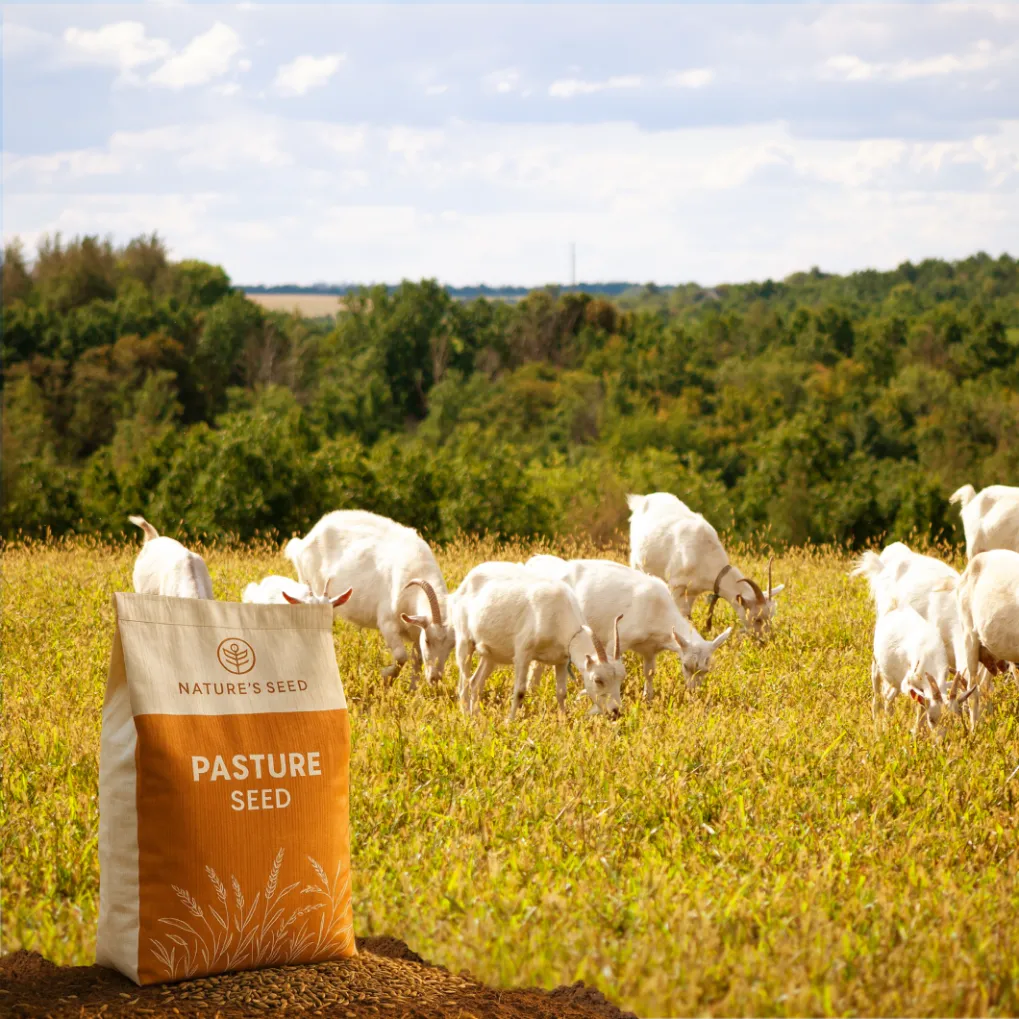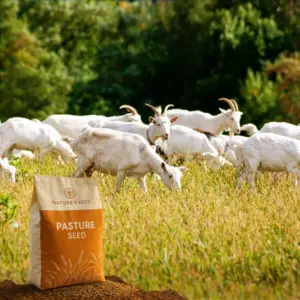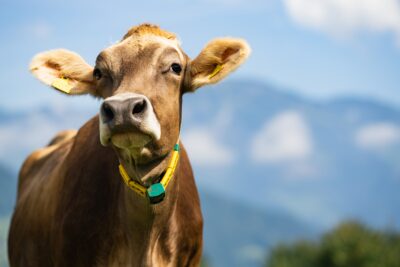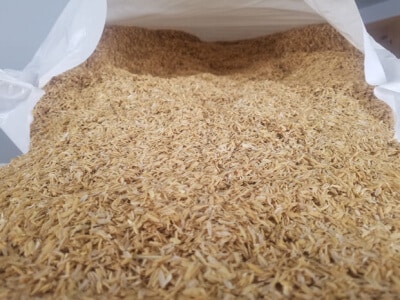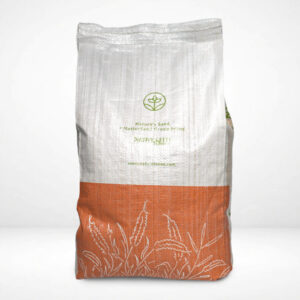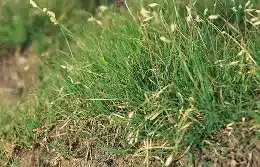What is the Southern Goat Pasture Mix?
A premium multi-species goat pasture seed blend for the Southern U.S., combining deep-rooted chicory, alfalfa, white clover, bermudagrass, and field peas. Thrives in hot, humid climates (USDA Zones 7–10) and provides year-round, protein-rich forage for healthy weight gain, milk production, and natural internal parasite control. Also improves soil fertility by fixing nitrogen and offers resilience against drought and grazing.
Specifications
Sun Requirement
Full sun
Soil Preference
N/A
Soil pH
6.0–7.0 is ideal
Time to Maturity
~90 days
Height when mature
4–8″
Seeding Rate
~20 Lbs/Acre
Planting Depth
1/8″ to 1/4″
- You cannot add "Cereal Rye" to the cart because the product is out of stock.
Goat Pasture & Forage Mix | Warm Season
SKU: PB-GOAT-S
- Goats
Will the seed work for your area?
Check your region
select quantity
Description
What seeds are in the mix?

Drought & Heat Tolerance
This blend is built for Southern extremes. Forage chicory develops a deep taproot that pulls moisture from deep soil, giving it excellent drought resistance. Alfalfa is similarly deep-rooted, and modern varieties are extremely heat and drought-tolerant. Bermudagrass, a warm-season grass, survives scorching summers and dry spells by going dormant and reviving with rain. Together, these species ensure the pasture stays green and productive when temperatures soar and rain is sparse. Even under heat stress, the mix can remain palatable and nutritious while other forages wither.

Erosion Control & Groundcover
The Southern Goat Mix forms a dense, soil-hugging sod that protects your land. Bermudagrass is well-known for its vigorous spreading habit and ability to form a tight turf, which is why it’s often used for soil stabilization and erosion control. White clover creeps via stolons, filling gaps and covering bare soil; in moist or fertile spots, it creates a lush green carpet that resists erosion. Deep roots from chicory and alfalfa anchor the soil on slopes, improving water infiltration and reducing runoff. By planting this mix, small landowners can establish a living cover that holds topsoil in place during heavy Southern downpours. The result is improved soil structure and prevented gullying on pastures.
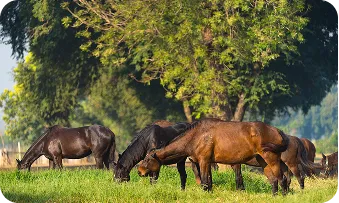
Grazing Resilience & Persistence
This blend holds up well under grazing, especially with proper management. Bermudagrass tolerates close, continuous grazing and recovers quickly, while chicory and white clover thrive with rotational grazing and periodic rest. Goats naturally rotate their grazing, favoring chicory and clover first, which helps balance pressure on the grasses. Under a system where animals are moved at ~3–4″ stubble height, the mix regrows vigorously. Bermudagrass spreads to repair bare spots, and the legumes can reseed. Even continuous grazing is possible, but rotation will maximize longevity and forage quality, delivering a productive pasture for years to come.
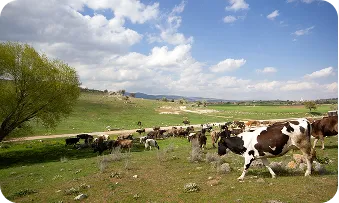
Animal Nutrition & Health
Goats and other livestock thrive on the rich nutrition in this mix. Legumes like alfalfa, clover, and peas deliver over 15% crude protein—ideal for growing kids, meat goats, and lactating does—along with calcium and key minerals for bone and milk health. Chicory adds leafy forage with alfalfa-like value and high mineral content, plus natural tannins that help reduce internal parasites like Barber Pole worm. Goats love its flavor, making it a favorite alongside clover and alfalfa. Bermudagrass adds fiber for rumen health and helps balance the legume-rich diet. The result: healthier, shinier, more productive animals—naturally.
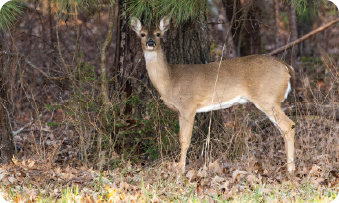
Pollinator & Wildlife Benefits
Beyond nourishing your goats, the Southern Goat Forage Mix boosts on-farm biodiversity. When parts of the pasture are allowed to bloom, clover, alfalfa, and chicory attract bees, butterflies, and other pollinators, creating a mini wildflower meadow that benefits nearby gardens and orchards. Wildlife like deer, turkeys, and songbirds are also drawn to the mix, feeding on tender shoots, seeds, and insects. Even soil life thrives under this diverse, perennial cover. It’s more than just forage—it’s a pasture that supports your whole farm ecosystem.
Description
What seeds are in the mix?
Detail Product
Sun/Shade
Full sun
Height
~8″
Seeding Rate
~20 Lbs/Acre
Uses
Goat and sheep pasture, cattle grazing supplement, soil improvement cover crop, wildlife food plot (deer/turkey), erosion control on slopes, pollinator meadow integration. Not intended as a turf lawn.
Color
Lush green foliage
Water
Lush green foliage
Native
Mix comprises introduced species
Life Form
Perennial Herbaceous plants
Product Uses
Smart Grazing for Healthy Goats
Southern Goat Forage Mix is tailored for goat nutrition, offering protein-rich forage like chicory, clover, and alfalfa with bermudagrass for fiber. Ideal for meat and dairy goats, it also suits sheep and cattle (watch clover bloat in cattle). Use rotational grazing (8–10″ down to 3–4″) to extend pasture life and minimize feed costs. Provide water, minerals, and manage grazing to prevent overuse.
Erosion Control for Southern Slopes
If you have hilly or erosion-prone land in the South, Southern Goat Forage Mix also works as a natural erosion control. Bermudagrass spreads through runners, while clover and chicory roots anchor soil. It’s ideal for grazed slopes, pond edges, or runoff-prone areas. Once established, it reduces soil loss, improves water infiltration, and protects against storm damage. For best results, use mulch at planting and delay grazing until rooted.
Pastoral Looks, Minimal Upkeep
Southern Goat Forage Mix isn’t just for grazing—it also works as a low-maintenance, self-sustaining ground cover for rural properties. Once established, it requires little upkeep: clover and alfalfa provide natural nitrogen, and the mix regrows annually without replanting. Mow once or twice a year to maintain a lush, pastoral look with clover blooms and blue chicory flowers. It’s pet- and family-friendly, free of toxic endophytes, and ideal for homesteads, agri-tourism, or managed natural landscapes. Just mow in late summer and occasionally overseed clover for best results.
Grow Forage, Grow Biodiversity
Turn your pasture into a dual-purpose space that supports both livestock and wildlife. Southern Goat Forage Mix attracts deer, rabbits, quail, and turkey thanks to highly palatable species like chicory, clover, and peas. Deer benefit from the high-protein forage for antler growth and body condition, while birds feed on clover seeds and insects in the pasture.
When allowed to flower, the mix draws in bees, butterflies, and hummingbirds, supporting local pollinators and nearby gardens. Its diverse structure also shelters small game and promotes insect life for bats and nocturnal species. For added wildlife benefit, leave some areas ungrazed during key seasons or let clover go to seed in late summer. This mix can turn your pasture into a vibrant, wildlife-friendly habitat.
Questions & Answers
What exactly is the Southern Goat Forage Mix, and what’s in it?
Southern Goat Forage Mix is a five-species blend tailored for goat pastures in the Southern U.S. It includes forage chicory, alfalfa, white clover, bermudagrass, and field peas—each chosen for nutrition, resilience, and grazing tolerance. The mix delivers a balanced diet rich in protein, fiber, and minerals, while thriving in the Southern climate. With broadleaf forbs, hardy grasses, and nitrogen-fixing legumes, it’s a complete, non-GMO solution for healthy goats and long-lasting pasture.
Will this mix grow well in my area? (Which regions and conditions are suitable?)
Southern Goat Forage Mix is ideal for USDA Zones 8-10
How and when should I plant this seed mix to get the best results?
The best time to plant Southern Goat Forage Mix is in spring, once the danger of frost has passed and soil temps reach 60–65°F—typically March–April in the Deep South and April–early May in upper Southern areas. This timing allows warm-season species like bermudagrass and chicory to establish with spring rains.
Quick Planting Guide:
-
Site Prep: Clear weeds and create a firm, fine seedbed. Consider spraying weeds 2–4 weeks before tilling. Cultipack after tillage to firm the soil—your boot should sink no more than ½ inch.
-
Seeding: Broadcast or drill at 20–25 lbs/acre. If broadcasting, mix seed with a carrier (sand, pelletized lime), then drag lightly and cultipack. Drill small seeds ⅛–¼″ deep; pea seeds can go ½–1″.
-
After Planting: Keep the soil moist for 1–2 weeks. Germination begins in 5–21 days (peas/clover first, bermuda last). Avoid nitrogen fertilizer at planting; phosphorus and potassium are fine based on the soil test. Inoculate legumes if seeds aren’t pre-coated.
-
Fall Planting Option: In warm coastal areas, you can plant in early fall (Sept.), but only if frost comes late—allow 6–8 weeks for establishment.
-
First Season Care: Control weeds with light mowing (8″), delay grazing until the stand is rooted and 8″ tall. Usually, the first grazing is safe about 3 months after planting.
With proper timing and care, you’ll have a strong, resilient pasture that improves with each season.
How soon can I let my goats (or other livestock) graze this pasture, and how should it be managed for grazing?
Patience during establishment pays off—wait 80–100 days after spring planting before grazing. While clover and peas come up quickly, deeper-rooted species like chicory and alfalfa need time to anchor. Only begin grazing once the stand averages 8″ tall and bermudagrass is well-rooted.
First Grazing Tips:
-
Start gradually: let goats graze for short periods at first to help their rumens adjust.
-
Keep it light: don’t graze below 3–4″ (especially for alfalfa), and avoid scalping the pasture.
-
For patchy grazing, use a mower or run sheep/cattle behind goats to even it out.
Rotational Grazing = Best Results:
-
Divide into paddocks and rotate when forage hits 8–10″, moving animals off at ~3″.
-
Rest each paddock for 25–35 days, depending on growth rate.
-
This improves forage regrowth, maintains legume persistence, and reduces parasite loads (most larvae live in the lowest 2–3″ of pasture).
If Continuous Grazing:
-
Keep stocking low to avoid overgrazing.
-
Supplement with hay when forage dips below 3″.
-
Avoid grazing on saturated soils to prevent root damage, especially to alfalfa crowns.
Multi-Species Notes:
-
Sheep and cattle graze well on this mix.
-
Horses should be limited—they may uproot plants and can be sensitive to high-clover diets.
Long-Term Maintenance:
-
No nitrogen fertilizer needed—clover and alfalfa fix it.
-
Fertilize with P, K, and lime per soil test to keep legumes healthy.
-
If legume content drops below 30%, overseed clover in late winter to maintain soil fertility and balance.
With good management, this mix creates a lush, self-renewing pasture that delivers excellent gains and long-term productivity for your herd.
Is this mix safe and suitable for goats nutritionally? (Any bloat concerns or special benefits?)
Yes, this mix is highly suitable for goats—it was specifically designed to meet their dietary needs. Goats require high-protein forage (12–16% crude protein), and this blend delivers that with alfalfa, clover, peas, and chicory—all rich in protein and highly digestible. Bermudagrass adds fiber to balance the legumes.
Bloat risk is minimized due to the mix’s diversity. While legumes like alfalfa and clover can cause bloat, goats are less susceptible than cattle and tend to graze selectively. Chicory also contains tannins that help reduce bloat and parasite loads, offering additional health benefits.
Field peas and bermudagrass further reduce bloat potential, and the mix supports excellent growth, milk production, and coat quality. With proper grazing management and free-choice minerals, this pasture can serve as a complete diet during the growing season. It’s not just safe—it’s one of the best options available for goat health and productivity.
Does this mix really help with internal parasites (worms) in goats, or is that just a myth?
Yes, this mix can help with parasite management, especially thanks to forage chicory. Chicory contains condensed tannins with proven anti-parasitic effects, reducing worm larvae survival and fecal egg counts. Goats grazing tannin-rich forages like chicory often show fewer issues with Barber Pole worm.
The mix also supports rotational grazing, a key strategy in parasite control. Since most larvae live in the lower 2–3″ of forage, moving goats before overgrazing reduces exposure. Fast regrowth and the presence of less-preferred, low-growing species like bermudagrass further help limit parasite intake.
While clover and alfalfa don’t kill parasites directly, they boost nutrition, improving immune response and recovery. High-protein diets help goats resist and recover from worm burdens.
In short, this mix isn’t a dewormer, but it significantly supports parasite control when combined with good grazing and monitoring practices. Many producers report needing fewer treatments, making this mix a valuable tool in a holistic health plan.
Still have
questions?
Our planting experts
are here to help.
Call Us
1-800-123-4567
8 AM–5 PM
Monday–Friday
Reviews
A premium multi-species goat pasture seed blend for the Southern U.S., combining deep-rooted chicory, alfalfa, white clover, bermudagrass, and field peas. Thrives in hot, humid climates (USDA Zones 7–10) and provides year-round, protein-rich forage for healthy weight gain, milk production, and natural internal parasite control. Also improves soil fertility by fixing nitrogen and offers resilience against drought and grazing.
| Weight | N/A |
|---|---|
| Coverage Area |
